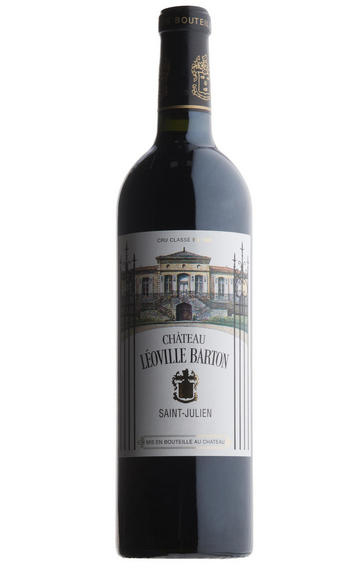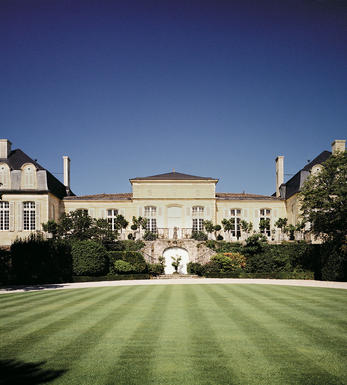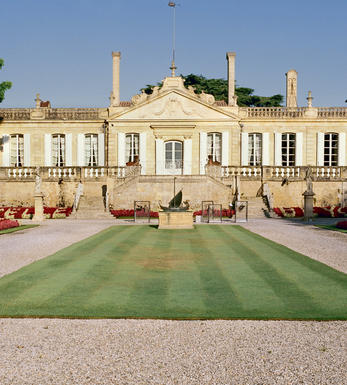
2005 Château Léoville Barton, St Julien, Bordeaux

Critics reviews
The 2005 Léoville-Barton is clearly one of the wines of the vintage. Powerful and strapping in the glass, the 2005 is a big, big wine. Huge swaths of tannin wrap around a core of inky black fruit, new leather, spice, gravel, mocha and liquorice. The wine's sheer density is impressive, but its balance is even more compelling. I might be tempted to give this another few years in the cellar. Readers lucky enough to own it will find a thrilling, potent Saint-Julien that over-delivers big time. I loved it.
Drink 2023 - 2045
Antonio Galloni, Vinous.com (April 2021)
Tasted blind. Healthy, deep crimson. Clean, intense nose. Lots of ripe, if slightly simple, blackcurrant fruit. Dusty end. No charmer! A mouthful of minerals. But there is life here, too.
Drink 2020 - 2040
Jancis Robinson MW, JancisRobinson.com (March 2017)
The Château Léoville-Barton 2005 has a more multi-dimensional bouquet than the Langoa with blackberry, bilberry, a hint of “Liquorice All Sorts”, and crème de cassis. The palate is medium-bodied with dense ripe tannins, a gentle but insistent grip and superb delineation on the finish that reins the power back in, ensuring that this Barton is a linear classic in style. There is excellent persistence here – a Saint Julien from the top drawer that will give as much pleasure to you as your kids (once they reach drinking age, of course).
Drink 2019 - 2050
Neil Martin, Wine Advocate (February 2015)
This offers aromas of spices, dried dark fruits, meat and berries. Full and muscular on the palate, with strong tannins and a long, long finish. This is very powerful and chewy but a little bit tight. This is a wine for the cellar.
Drink from 2018 onwards
James Suckling, JamesSuckling.com (December 2010)
What can you say about Anthony Barton? He has made yet another classic wine that will not be approachable for a decade but will last 50 or more years. The inky/blue/purple-coloured 2005 Leoville Barton offers up aromas of forest floor, cedar, spice box, black currants, background oak, and smoke.
Boasting massive concentration, full body, and exceptional purity, but excruciatingly tannic and backward, this cuvee is meant for those with 19th-century tastes but exhibits modern winemaking's purity and precision. Patience is demanded with this beauty, as it will take many years to approach any level of accessibility/maturity.
Anticipated maturity: 2020 - 2060+
Robert M. Parker, Jr., Wine Advocate (April 2007)
Deep ruby. The wonderfully perfumed nose offers cassis, minerals, tobacco, flowers, mocha and truffle. Bright, mineral-driven and concentrated, with a terrific underlying backbone giving energy and definition to the dark berry, mineral and chocolate flavours. A floral lift here is exhilarating to find in the very ripe 2005 vintage. Finishes very long and classy, with a firm tannic spine. This is an outstanding vintage for this wine.
Stephen Tanzer, Vinous.com (May 2008)
About this WINE

Chateau Leoville Barton
Château Léoville Barton is the smallest portion of the great Léoville estate and has been owned by the Barton family since 1826. There is no château and the wine is made at Langoa Barton.
Léoville Barton's 48 hectares of vineyards are located in the east of the St-Julien wine appellation and lie on gravelly-clay soils. They are planted with Cabernet Sauvignon 72%, Merlot 20%, Cabernet Franc 8%. The wine is matured in oak barriques (50% new) for 18 months.
Eighth and ninth-generation family members Lilian and Damien Barton took over the reins here in 2022, after the death of Anthony Barton. Anthony was responsible for the quality at Léoville Barton soaring; his tenure saw the wine changing from a solid, mid-performing 2ème Cru Classé to one of the most exciting and scintillating wines in St. Julien. Under Lilian and Damien’s care, business at the château is better than ever.
Léoville Barton is tannic and austere in youth but with time develops the classic cedary character that is the hallmark of St. Julien, along with intensely pure blackcurrant and cassis fruit notes. Léoville Barton's wines are made for extended cellaring and tend to show at their best with 10-15 years of bottle ageing.

St Julien
St Julien is the smallest of the "Big Four" Médoc communes. Although, without any First Growths, St Julien is recognised to be the most consistent of the main communes, with several châteaux turning out impressive wines year after year.
St Julien itself is much more of a village than Pauillac and almost all of the notable properties lie to its south. Its most northerly château is Ch. Léoville Las Cases (whose vineyards actually adjoin those of Latour in Pauillac) but, further south, suitable vineyard land gives way to arable farming and livestock until the Margaux appellation is reached.
The soil is gravelly and finer than that of Pauillac, and without the iron content which gives Pauillac its stature. The homogeneous soils in the vineyards (which extend over a relatively small area of just over 700 hectares) give the commune a unified character.
The wines can be assessed as much by texture as flavour, and there is a sleek, wholesome character to the best. Elegance, harmony and perfect balance and weight, with hints of cassis and cedar, are what epitomise classic St Julien wines. At their very best they combine Margaux’s elegance and refinement with Pauillac’s power and substance.
Ch. Léoville Las Cases produces arguably the most sought-after St Julien, and in any reassessment of the 1855 Classification it would almost certainly warrant being elevated to First Growth status.
Recommended Châteaux: Ch. Léoville Las Cases, Ch.Léoville Barton, Ch Léoville Poyferré, Ch. Ducru-Beaucaillou, Ch Langoa Barton, Ch Gruaud Larose, Ch. Branaire-Ducru, Ch. Beychevelle

Cabernet Sauvignon Blend
Cabernet Sauvignon lends itself particularly well in blends with Merlot. This is actually the archetypal Bordeaux blend, though in different proportions in the sub-regions and sometimes topped up with Cabernet Franc, Malbec, and Petit Verdot.
In the Médoc and Graves the percentage of Cabernet Sauvignon in the blend can range from 95% (Mouton-Rothschild) to as low as 40%. It is particularly suited to the dry, warm, free- draining, gravel-rich soils and is responsible for the redolent cassis characteristics as well as the depth of colour, tannic structure and pronounced acidity of Médoc wines. However 100% Cabernet Sauvignon wines can be slightly hollow-tasting in the middle palate and Merlot with its generous, fleshy fruit flavours acts as a perfect foil by filling in this cavity.
In St-Emilion and Pomerol, the blends are Merlot dominated as Cabernet Sauvignon can struggle to ripen there - when it is included, it adds structure and body to the wine. Sassicaia is the most famous Bordeaux blend in Italy and has spawned many imitations, whereby the blend is now firmly established in the New World and particularly in California and Australia.


Buying options
Add to wishlist
Description
The 2005 Léoville-Barton is clearly one of the wines of the vintage. Powerful and strapping in the glass, the 2005 is a big, big wine. Huge swaths of tannin wrap around a core of inky black fruit, new leather, spice, gravel, mocha and liquorice. The wine's sheer density is impressive, but its balance is even more compelling. I might be tempted to give this another few years in the cellar. Readers lucky enough to own it will find a thrilling, potent Saint-Julien that over-delivers big time. I loved it.
Drink 2023 - 2045
Antonio Galloni, Vinous.com (April 2021)
wine at a glance
Delivery and quality guarantee